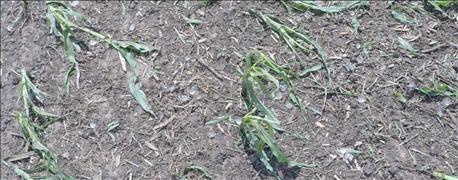May 15, 2016

According to the May 8 USDA crop progress report, about 53% of Nebraska's corn acres have been planted and 15% of the crop has emerged. Violent storms with heavy winds and hail swept through central and eastern Nebraska last week, leaving behind a reminder of the potential losses that can occur from early-season hail damage to corn.
Yield losses from hail storms depend on the timing and severity of the hail and subsequent environmental conditions. Regardless of the level of damage, farmers should be patient when evaluating early-season hail damage in corn and wait 7–10 days after a hail event to allow for crop regrowth.

HAIL SIMULATION: Corn damaged artificially during research to study plant recovery over time. Photo credit: Justin McMechan.
To replant or not to replant
Replant decisions in corn require an estimate of the existing yield potential of the crop. This estimate is primarily based on the remaining live plant stand across an area. One method for developing an estimate would be to sample multiple areas within a field with each area equivalent to 1/1000th of an acre. Plants with abnormal growth are considered as "non-living" during this evaluation because their ability to recover is uncertain.
Percent yield loss of hail-damaged corn fields is estimated, based on original and remaining plant stand data using USDA Federal Crop Insurance Corporation tables. When replanting corn, growers must also consider calendar date, weed situation, seed availability, hybrid maturity group, crop value, and the cost of equipment and fuel.
Yield potential of surviving plants
Several questions have arisen about the yield potential of surviving corn plants following an early-season hail event. Previous studies have attempted to estimate this yield potential through artificial defoliation with highly variable results. Complete defoliation of V2 to V5 corn resulted in yield losses from 8.7% to 23%, respectively (Eldredge 1935).
In contrast, shredding or removing up to two-thirds of corn leaves from V2 to V5 plants resulted in less than 4% yield loss (Eldredge 1935).
~~~PAGE_BREAK_HERE~~~
Complete defoliation of V4 corn caused yield loss of 1.1% to 25.9% and were primary attributed to reduced ear size as a result of reduce leaf area and, to a lesser extent, a small change in plant population (Johnson 1978). Vasilas et al. (1991) evaluated the potential yield impact of uneven damage between plants in the same row by comparing plots with defoliation of every other corn plant to those with all plants defoliated during the early stages of plant development. Average grain yield was reduced by 12.3% when all plants were defoliated and by 8.3% when only half of the plants in the plot were defoliated (Vasilas et al. 1991).
Hail and bacterial plant pathogens
Variations in yield potential of a hail-damaged field may be due to presence of other yield-limiting factors. Plant damage incurred during hailstorms can allow bacterial pathogens to enter the plant. Goss's wilt is a bacterial plant pathogen that is most common and severe following hailstorms. Inoculum of Goss's wilt can remain viable on corn residue for up to 10 months. Infection occurs as a result of rain splash from crop-infected residue onto open plant wounds during a hailstorm. Rapid disease development occurs in a warm moist environment, and the optimal growth for Goss's wilt is between 75° F and 82° F, with arrested pathogen development and death occurring by 100° F. Fortunately, temperatures in that range are rare in Nebraska during spring.
Goss's wilt symptoms first appear as water-soaked lesions parallel to leaf veins with bacterial exudates that appear shiny. Yield losses of susceptible hybrids typically range from 44% to 63% when comparing resistant and susceptible hybrids. Preventative management strategies, such as crop rotation and resistant hybrids, are the most effective means of reducing the impact from this pathogen. Other pathogens such as bacterial stalk rots have the potential to cause additional yield losses in corn fields.
What should you do?
Patience is the best advice following a hail storm. Wait 7-10 days following the storm to assess damage and allow for plant recovery. The risk of additional yield losses from bacterial plant pathogens increases under continuous corn. Rotate with other crops when possible to reduce the potential for additional losses.
For additional information, contact Justin McMechan, doctor of plant health & entomology graduate student at [email protected] or Roger Elmore, Extension cropping systems agronomist at [email protected].
Source: UNL CropWatch
You May Also Like




